
Before you rush into creating a product thinking people will love it, it pays to perform a product-market fit analysis. You want to be sure there is a demand for your product, so you don’t have to suffer the embarrassment of a massive flop.
This article examines why product-market fit analysis is important and how to gather insights into achieving a product-market fit by getting feedback and validating your idea.
Try Userpilot Now
See Why 1,000+ Teams Choose Userpilot

Summary of a product-market fit analysis guide for product managers
- Product-market fit is where your company’s target customers purchase, use, and speak about the business’s product enough that it grows and is profitable.
- Product-market fit is important as it helps to identify your target market and market demand, so you don’t launch a product that customers don’t actually want.
- You can perform product-market fit analysis by conducting PMF surveys, measuring growth rate, calculating churn rate and customer retention rate, and researching what customers are speaking about you on social media.
- Building a Minimum Viable Product (MVP) can show you if there is a product-market fit without spending time building out an entire product that no one may be interested in.
- You can use forms for potential and existing customers to sign up as beta testers to determine if the product/feature has a demand.
- Use product feedback forms to improve your product by finding friction points or missing features.
- Successful product-market fit examples include Userpilot, Slack, and Dropbox.
What is product-market fit?
Product-market fit is where you identify a market need and create a product that customers want to buy because it helps them solve a problem.
It means finding a good market with a product capable of satisfying that market.
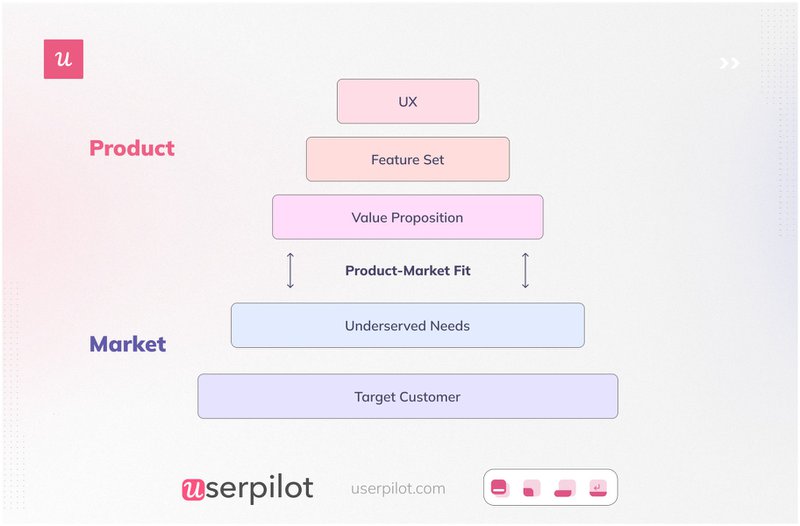
Why achieving product-market fit is important?
Product-market fit is important because a lot of effort goes into creating and launching a new product. If you’re doing it with no facts to back it up, from just a gut feeling, explaining to the executives why you have no customers can be embarrassing.
You need to understand if there is a need in the market for what you are offering. You’ll find that it’s a common reason why most startups fail because they have yet to understand if what they are building even has a product-market fit.
Another reason why it’s important is it helps you with direction. You could have a range of product ideas, but which one do you put effort into first? Product-market fit can provide you with the answer to which direction you should go first.
Product-market fit can also help with your positioning and messaging. Learning the voice of the customer can inspire your product messaging.
How to perform product-market fit analysis
As mentioned before, you want positive signals for your product before fully committing to something. The product-market fit analysis will provide you with insights that can indicate customer interest.
You want to gather qualitative and quantitative metrics to get concentrated figures in interest and product sentiment. Here are some methods of collecting that data to inform your product-market fit analysis.
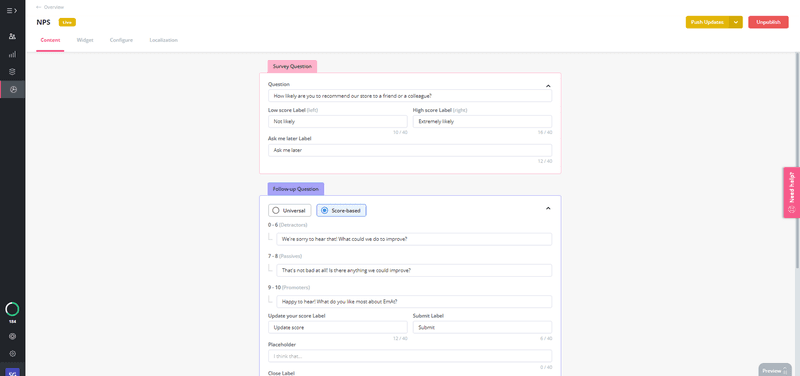
- NPS surveys: You can conduct NPS surveys to find how satisfied customers are with your products or features.
- PMF surveys: Can provide consumer feedback on if your product meets their needs and solves their pain points.
- Measure growth rate: You can measure the growth rate of your product to see how well the product attracts users. This information will tell you if your positioning and messaging fit the market.
- Calculate churn rate: If you have customers leaving in droves, your product may not provide the value that the customer expected. Or it may indicate a poor product-market fit.
- Word of mouth: Keeping a watch for product mentions can provide valuable information. If you notice a lot of negative talk about how your product doesn’t solve a particular problem, this can be a great signal for product development or iteration. You can set Google alerts to monitor your product mentions or do regular searches on social media.
How to achieve product-market fit for your product?
Now we know why product-market fit is important, how do you even work it out? Thankfully, we aren’t completely in the dark. There are a few ways to help determine your product’s market fit.
Conduct market research and develop an idea
The first thing that you need to do is start with market research. If you don’t have a market for your product, you’re already dead in the water.
You want to have as much information about your target market as possible to uncover viable opportunities.
If you want some expert advice on how to find product-market fit, watch our interview with the CEO and Co-founder of Prowly on how she discovered her product-market fit.
Determine your target customer and identify underserved customer needs
The first step in market research is understanding your target audience. If you are still determining who this is, you’re going to be able to know which channels to reach your customer are going to be.
You should clearly know what your user persona looks like from your target audience. Some of the questions you want to be able to answer are:
- Who are they?
- Where do they work?
- What are their underserved needs?
- What are their jobs to be done?
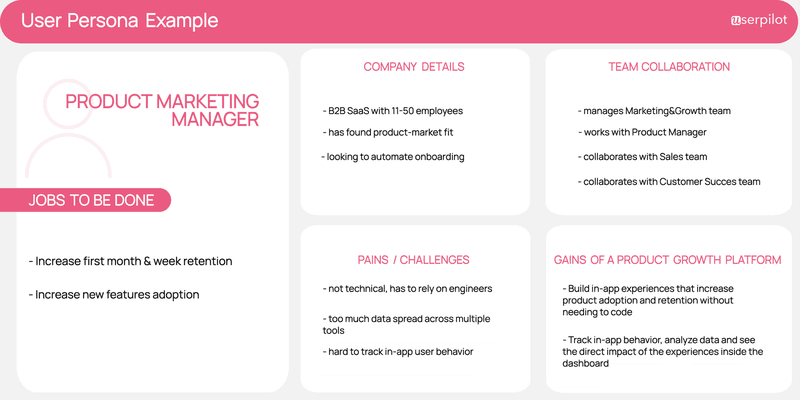
Define your product and value proposition
Another thing that you need is to define your value proposition. You need a value proposition that will fulfill your customer needs more than your competitors. Otherwise, why would a customer choose you over a competitor?
Think about the features you can add to your product that customers are looking for to solve their pains and make you a no-brainer choice over your competitors.
Build a Minimum Viable Product (MVP)
It’s all good and well conducting surveys and collecting customer feedback about what they want, but sometimes you need more. You need to be able to take action.
Building an MVP will demonstrate if people are, in fact, interested in your product by signing up and trying the product.
The MVP gives you a vehicle to prototype the ideas you have received in the research and test them with customers so you can hone in on how to drive the most value for your customers.
It is similar to the principle of Ready, Fire, Aim by Michael Masterson. The Ready stage is doing the market research (so you have an idea of the unserved customer needs). The Fire stage is the production of the MVP. And the Aim stage is refining the product offering based on how customers respond.
Use beta testers to validate your idea
Beta testers can be a great way to achieve product-market fit and determine demand.
You can conduct focus groups where you get a small group of people to dive deep into your product and provide intimate feedback.
If you have achieved product-market fit and want to test a new feature, you can ask your existing customers to test your new features.
You can take things a step further and utilize A/B testing, where you select different versions of your product to see which gets the most responses, signaling what might be the most effective features.
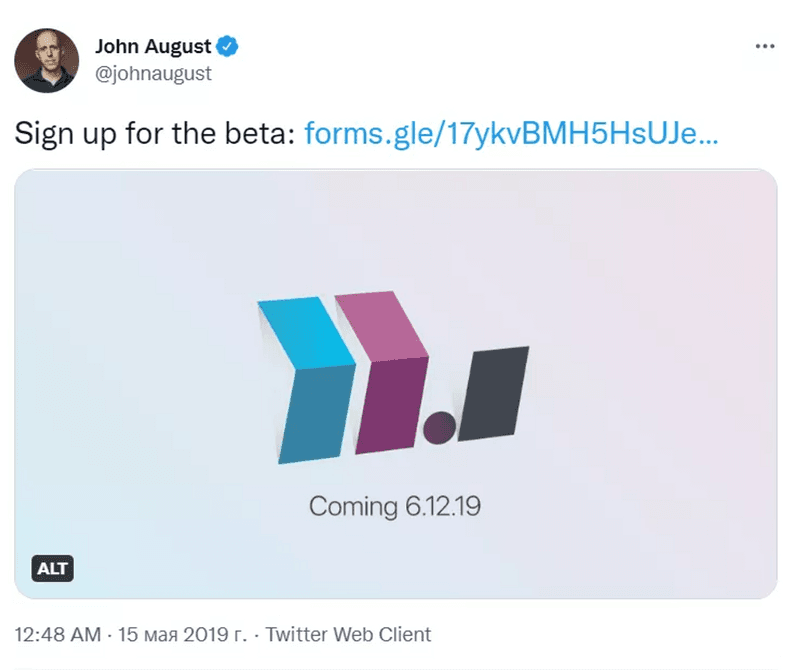
Collect customer feedback
Asking your existing customer or potential customer for feedback is a great way to understand how you can achieve product-market fit. You can harness surveys or feedback forms to collect customer feedback about your product.
A mixture of open-ended and multiple-choice questions will help you find friction points customers may have using your product and any features that customers may think are missing.
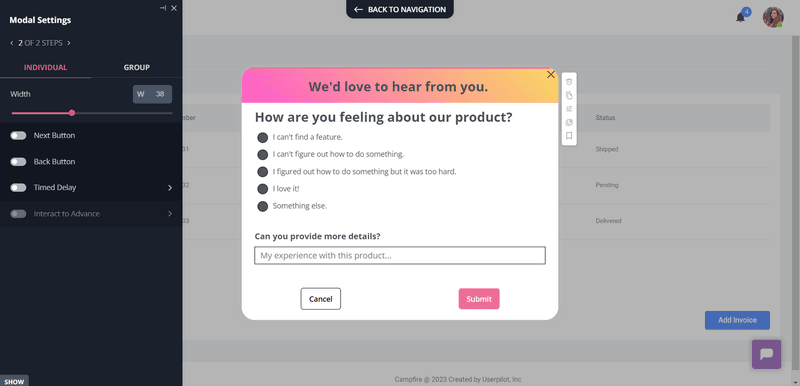
Iterate until you have PMF
The Sean Ellis test is a widely expected indicator of if you have a product-market fit based on a PMF survey. With PMF surveys, you give users one simple question: “How would you feel if you could no longer use this product?”
If 40% of the respondents say they would be very disappointed, you’ve achieved product-market fit.
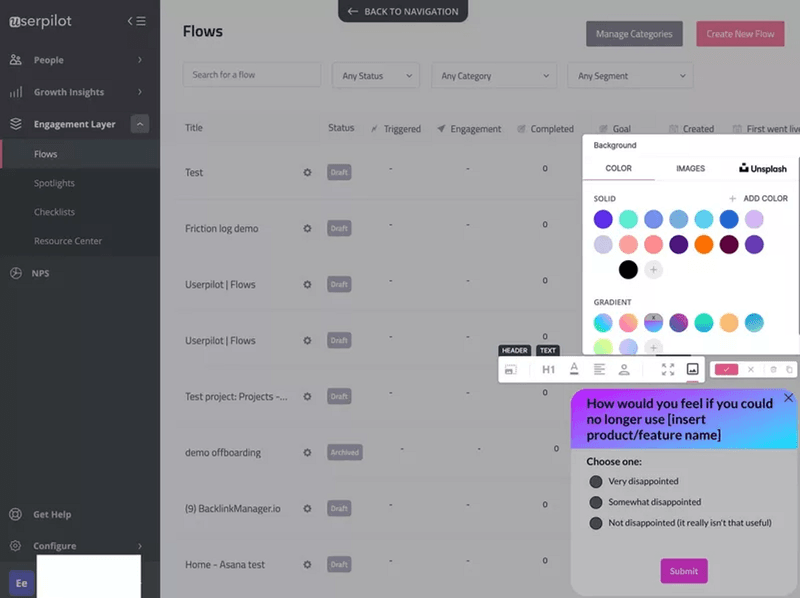
Continue to grow and constantly measure product-market fit
Product-market fit isn’t something you do once and then go all in with the product you’re developing.
As you grow, you want to know that your product is still relevant and still serves the purpose it initially intended for. So every time you develop a new feature, you need to ensure it is relevant to your target audience by doing beta testing and measuring PMF.
Successful product market fit examples
To help you understand further product-market fit, seeing real-life examples is always helpful. Here are three companies that achieved product-market fit.
Userpilot
Userpilot is a product adoption tool that originally started as an onboarding tool with an MVP consisting of Flows, Checklists, and Segments.
Userpilot’s MVP proved they had product-market fit as the user base grew. With that growth, it began to understand more of its customers’ unserved needs and started offering a range of features, such as analytics, survey functionality, and better onboarding elements, to help with its user’s end goal of product adoption.
Slack
Nowadays, Slack is a common tool for communication in business, but it wasn’t the original idea. The founders of Slack wanted to develop a role-playing game, and Slack was only meant as an internal communication tool.
After realizing that the market had plenty of role-playing games, they agreed there wasn’t a good market fit.
However, their little internal communication tool had the spotlight shone on it when they realized there wasn’t a product like it and now Slack now has a 10 million user base.
Slack’s success was that they pivoted to something else when they found a better product-market fit.
Dropbox
Dropbox solved the problem of files not syncing up over devices and cloud services by offering a file synchronization service. Even though this was a pain point in the market, Dropbox still had issues attracting users.
The co-founder Drew Houston knew there was a good product-market fit, so they devised two methods of increasing their user base.
First, he made a four-minute explainer video and leveraged a channel he knew already had an audience. He posted the video on Digg which had an audience of young, tech-savvy who would happily become early adopters. It worked. Dropbox’s beta waitlist grew from 5,00o to 75,000 overnight.
The second thing Drew did was start a viral referral campaign where if an existing user shared the service, they were rewarded with additional storage.
Sometimes you have to be persistent. Customers don’t come knocking at your door to sign up, even when identifying a market fit.
How to perform product-market fit analysis using Userpilot
Userpilot is a great tool to help you perform product-market fit analysis. Let’s explore this in detail.
Segment new customers to provide a personalized experience
With Userpilot, you can create different segments to collect targeted feedback for product-market fit analysis.
You can slice and dice specific user groups based on different criteria:
- User data – including name, id, plan, device type, signup date, and a huge array of others.
- Company data
- Individual feature usage.
- Pre-existing segments.
- Engagement profiles -including UI-patter specific, like ‘in progress’ checklists.
- User feedback – target a segment of users that might have complained about a specific bug via a survey, and directly inform them when it’s fixed.
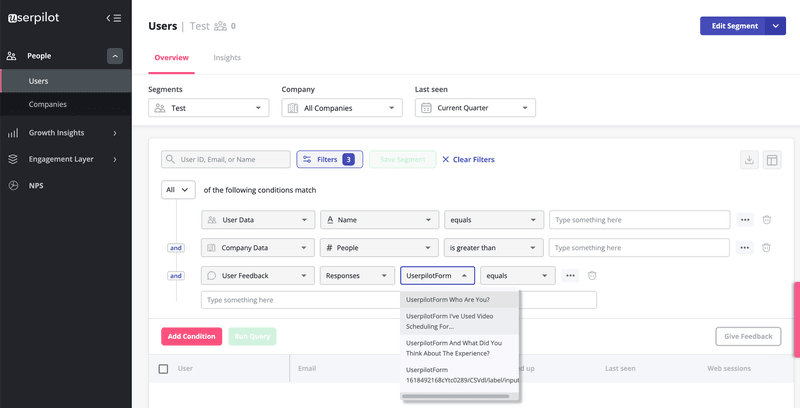
Create in-app surveys to collect customer feedback
With Userpilot, you can quickly create, customize and launch NPS surveys that fit the look and feel of your brand.
Customers can also trigger NPS on mobile and effortlessly gather valuable user insights and boost satisfaction on–the–go.
While NPS is powerful, it’s really a specialist tool to understand loyalty. What about more tactical, directly actionable insights to help you make decisions regarding product-market fit?
With Userpilot, you can create and customize different in-app surveys and choose when and where in your application it makes sense to launch them.
Using in-app surveys can help you collect user feedback. The response you receive enables you to tweak the direction in which to take your product.
You can also tag the responses to see the full picture of your customers and how they feel and follow up with certain questions based on those responses.
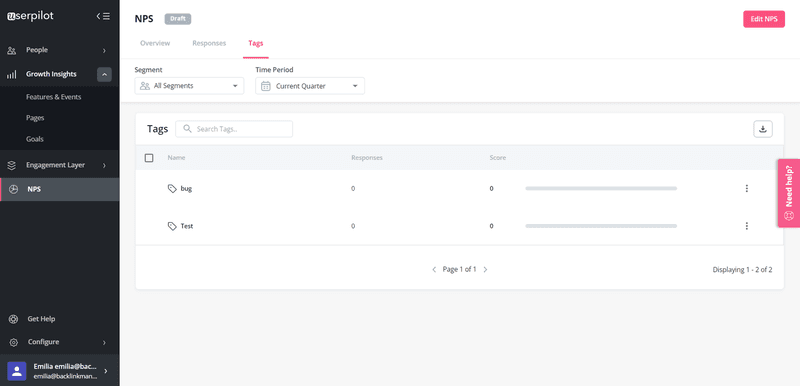
Determine product-market fit with feature usage
You can tag different features in your product to see if you are delivering a service that your users value.
With feature tagging, you can see how users interact with your product and quickly spot underperforming features that can indicate a poor product-market fit.
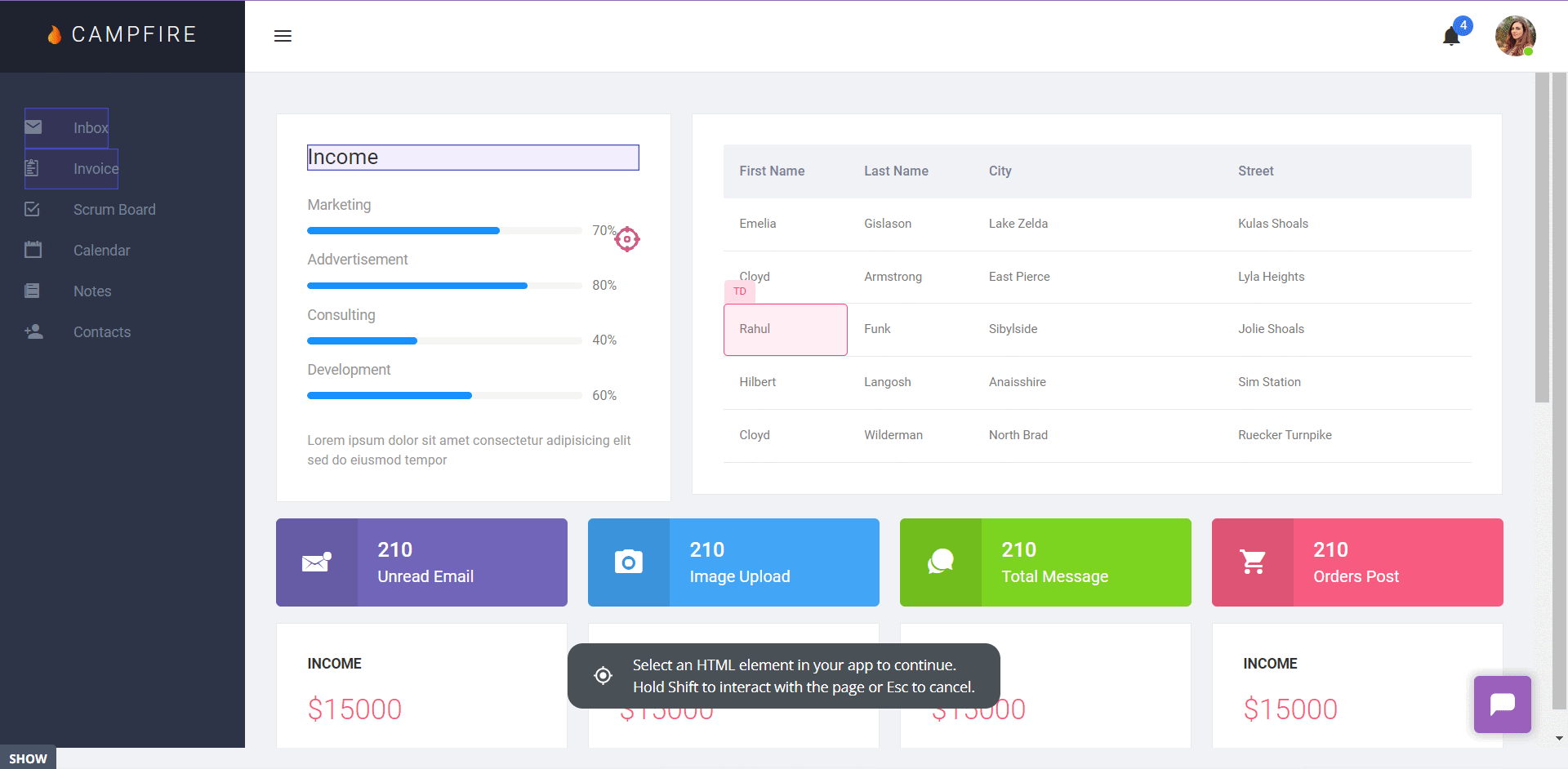
Conclusion
Diving into product creation without conducting any product-market fit analysis will likely leave you with a product used by a handful of people. Product-market fit isn’t a once-and-done process; you should keep doing it to help steer you in the right direction.
Want to get started with product-market fit analysis? Get a Userpilot Demo and see how you can develop a product that your customers will love.





